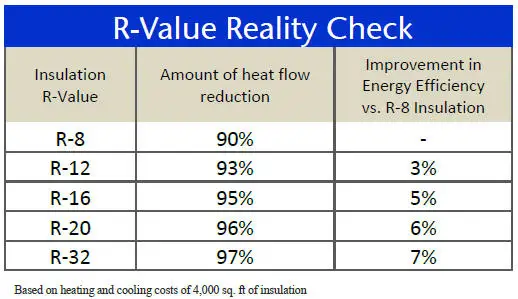About Garage Door Insulation
A garage door is often the main entrance for many homes. Whether you’re coming or going in your car, or coming and going from your house, the garage sees a lot of action. It’s also the largest entrance to your home and it can be a major source of heat loss. In the winter, a home can experience heat loss through the garage door and in summer, the garage can be a source of excess heat from the outside. As a result, many homeowners consider garage door insulation to reduce heat transfer through the door. In addition, insulated garage doors result in quieter operation while providing more strength and durability. In this article, we’ll dive into the options available for insulated garage doors.
Benefits of Insulated Garage Doors
There’s a lot of upside to insulating your garage door and little downside except added cost. However, the added cost is usually offset over time with energy savings so it’s worth serious thought.
Reduced Heat Loss
The biggest benefit of insulated garage doors is the reduction in heat transfer through the door. Just like the walls of your house, an insulated door tends to keep the inside temperature at a more comfortable level. In the winter, we may say it keeps the cold out. Actually, it’s keeping heat in so you don’t spend as much on heating costs. In hotter weather, the insulated door reduces heat transfer from the hot air outside so your garage area stays more comfortable.
Many homeowners use their garage space for more than parking cars. For example, many homes have laundry in the garage. In addition, it’s not unusual to find a workshop, exercise equipment or even additional living space. So keeping the garage space at a comfortable temperature is huge benefit.
A garage door with no insulation will typically see a 20 degree difference between inside and outside air temperature. On the other hand, an insulated garage door may see a difference of 40 to 50 degrees. So when it is freezing outside (32F), you may find yourself at a very comfortable 70 degrees or more!
Quieter Operation
Data has shown that an insulated door can be 15db quieter than a door with no insulation. As a result, the operation will be nearly 3 times quieter. The insulation itself acts as a noise damper but also reduces the metal vibration as the door operates. In short, you can expect a dramatic reduction in noise from your door.
Added Durability
Insulated garage doors can be stronger and more durable when the insulation is in the panel. However, aftermarket insulation kits that have insulation foam sheets applied to a traditional metal door may not get the same boost in strength. That’s because a garage door panel with an insulating foam in its core provides some shock absorption and rigidity adding to the panel strength.
How To Compare Insulated Doors
Insulation is rated using an “R-Value” to indicate its ability to resist the transmission of heat. The higher the R-Value, the slower the heat transfer through the insulating material. So in winter, this keeps the warm air in the garage and in summer keeps the heat out.
 R-Values for garage doors range from R-0 (no insulation) to R-20 or so. Homeowners should be aware that the R-Values are not linear. In other words, an R-16 door does not have twice the insulating capability as an R-8 door. Take a look at this chart to see the difference. You can see that an R-16 door provides a 5% improvement in insulation and R-20 only a 6% improvement. So no need to pay a crazy amount of money to get a modest improvement in insulation.
R-Values for garage doors range from R-0 (no insulation) to R-20 or so. Homeowners should be aware that the R-Values are not linear. In other words, an R-16 door does not have twice the insulating capability as an R-8 door. Take a look at this chart to see the difference. You can see that an R-16 door provides a 5% improvement in insulation and R-20 only a 6% improvement. So no need to pay a crazy amount of money to get a modest improvement in insulation.
Aftermarket insulation kits can be found offering R-Values between R-2 and R-8 where insulated garage doors range from R-6 to R-20.
Insulation Materials
Most garage doors use either polystyrene or polyurethane to provide insulating properties. Read on to understand the difference so you can choose which is right for you.
Polystyrene Insulation

Polystyrene Insulation
Polystyrene comes as rigid panels that usually have a vinyl backing. The panels are inserted between metal layers of the garage door during the manufacturing process. In addition, most aftermarket insulation kits use these types of panels. These panels will typically provide an R-8 insulation factor, depending on how well they are fitted. Any areas not covered by the panel will be subject to more heat transfer or heat loss.
Polyurethane Insulation
Polyurethane is available as a spray foam and is injected between the metal layers of the door. The advantage of the foam is that it can fill in all the gaps between the door layers providing a tighter seal and higher R-Value. Additionally, the foam sticks to the door frame providing added strength and some dent resistance.

Polyurethane Insulation
Polyurethane is the superior choice for door insulation and of course is more expensive. However, if you are in an area that gets very cold and you want to keep the garage space more comfortable, this may be a good investment.
Garage Door Insulation Choices
Like most things in life, garage door insulation is a trade-off between cost and comfort. Folks who live in wintery climates like Idaho will get a lot more out of an insulated door than someone in a milder climate like California. If an insulated garage door is right for you, the choice is how to get there. You can use an aftermarket kit as an affordable option and get something in the R-8 range. On the other hand, if you need more insulation or are getting a new garage door, you’ll want to explore insulated garage door options from vendors to find the right solution for your budget. Hopefully the information presented here helps with your choice!











